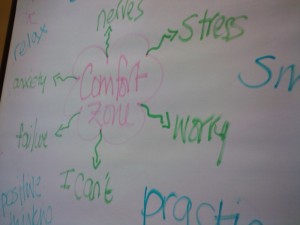A three-step guide for dealing with nerves and anxiety
Public speaking, interviews, acting, difficult conversations … they all have one thing in common: nerves. And for so many, the physical and emotional effects of anxiety can be overwhelming.
Here’s a simple three step plan for dealing with those nerves.
Prepare your stuff
Plan it – where you’re going, how to get there and what to wear early on. Get it out of the way first and edit out distracting fuss, fluster and faff.
Prepare it – write it, read it, study it, research it, learn it inside out. Whatever you’re about to do, that familiarity will help.
Practice it – run the presentation, practice answers to the questions, rehearse your performance, and take feedback you can trust. Then practice some more. The more you do it, the more natural it will feel.
Prepare your mind
Think positive – use positive language as you think, write and speak. You’re ‘excited, anticipating success and taking a great opportunity’, not ‘anxious, frightened and scared’. Edit out the word ‘nerves’ – think ‘energy, power and fuel’ instead.
Visualise your favourite image of energy and power – a racehorse, a sports car or Thunderbird 1? That’s you.
Visualise yourself looking good, doing well and the audience appreciating you. Remembering that most people are nice and want you to do well is a great way to prepare to meet them.
Prepare your body
As you step up to speak …
Relax. It only takes a moment to let that unecessary tension go. Stand up straight, head up, shoulders dropped, hands lightly clasped in front, feet hip-width apart. Now you’re centred.
Breathe – from the diaphragm, not from the chest, slow and deep. Now you’re calmer.
Connect – make eye contact, smile, pause while you take a comfortable breath … and yes, your heart will still be racing. It’s pumping oxygen round your system, the fuel you need as a vital, positive force to be reckoned with.
Now you’re ready to speak. As soon as you begin, you’re using all that advance planning, preparation and practice, harnessing all that fuel and putting it into action. This is what it was all for.
Good luck – and enjoy speaking well in public.

